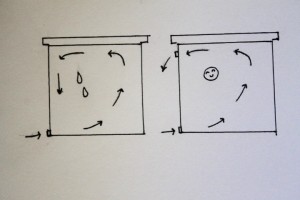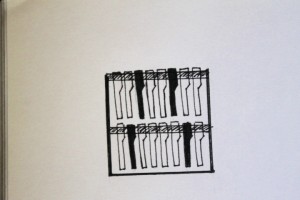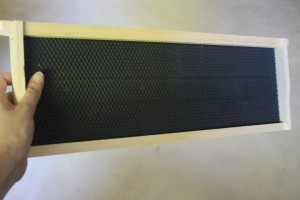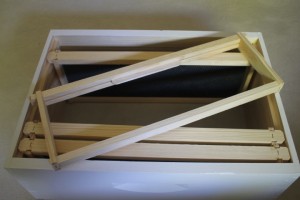After researching more about plastic’s relationship within the hive, I decided I wanted to change up the hand-made structure of the boxes. I am trying to find a solution that settles my scientific inquiry as well as my moral compass so I began with redesigning the hive.
The original set up that I planned to assemble included a bottom board, entrance reducer, two medium boxes (slightly larger than one deep), an inner cover, and an outer telescoping cover. With this plan, the only entrance and ventilation came from the entrance-reducer with space wide enough for about two bees to exit or enter the hive at a time. The inner frames are made of wood with plastic foundation and there are eight frames per box.
The first package of bees arrived the third week of April from California. For the first two weeks after their arrival, they lived in this set up. As I spoke to other local beekeepers, I slowly started adjusting the hive to cooperate with the surrounding environmental factors, mostly humidity.
Inside the hive, the temperature ranges from 90°-95° Fahrenheit and is regulated by the movement of bee wings. Air comes in to the hive from the entrance and circulates up to the top covers. In humid areas, this air is more likely to stay high and turn into condensation or mold. Condensation within the hive is seen as a stressor to the bees and leads to a possibility of fermented comb if left untreated for too long.

Diagram on the left shows airflow of a one-vent hive. Right diagram shows airflow of a two-vent hive.
To solve this issue, many beekeepers will create a second entrance or even a second ventilation spot for rising air to circulate out of the hive. For my hive, I began by sawing a ¾ inch slot in the thick board of the inner cover. It is small enough that air can escape, but bees will still need to use the bottom entrance for travel.
Speaking of the entrance, I also changed the size of the doorway and encouraged more flexible traffic patterns. To do this, I flipped over the bottom board to expose the more thinly spaced side to the hive and removed the entrance reducer that had been sitting on top of it. This will encourage more room for foraging bees to leave and return to the hive while offering more ventilation. In the winter, I will eventually replace the entrance reducer to keep out cold air.
For the second package of bees that arrives this Friday, I will be using these same ventilation practices on the second hive structure. However, on the new hive I will be experimenting with foundationless-framework, meaning that this new hive will be plastic-free. But to clarify, my plan for this hive will not be completely foundationless until the end of this hive’s first week. I still plan to use four plastic frames in the two boxes as an extra guide until the bees beginning building comb on the plastic-free frames. At that point in time, I will replace the plastic frames with foundation-less as well.

Diagram of a side view of the hive. The black frames represent where I will be placing the plastic guides during the first week before they are removed and replaced with foundationless frames.
To convert my frames to foundationless, I popped out the plastic in each one and replaced extra-large wooden popsicle sticks into the groove that once held the plastic. The sticks will act as a guide and a suggested starting place for the bees to beginning building comb.
I’m curious to see the differences between the two hives given their different internal designs. I have read that foundationless hives often begin building comb much quicker than hives that use plastic and that often there is concern over the bees “messing it up.” I say now, before I have even personally worked with this kind of design, that the phrase “messing it up” seems questionable and human-centric to me. The fear is that the bees will begin creating comb starting from the bottom of the frame instead of the top and create a more difficult job for the beekeeper to examine the hive’s health. The only thing that the bees could possibly mess up is the simplicity that we have created to examine in on their lives. There is no other harm in their desired cultivation of comb than the inconvenience that it sometimes leaves for us.
But anyway, more on the installation of the hive later, and comparison photos of the two different formations of comb.




Leave a Reply